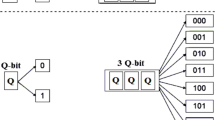Abstract
With the help of a model of an associative parallel processor with vertical processing (STAR computer), Prim-Dijkstra and Kraskal algorithms for finding a minimal spanning tree of an undirected graph represented in the form of a list of edges and their weights are compared. A relatively simple representation of the Prim-Dijkstra algorithm is constructed in which the initial node is taken into account. The Kraskal algorithm is also presented and the possibility of eliminating the stage of preliminary sorting of edges by their weights is shown.
Similar content being viewed by others
References
Y. I. Fet, “Vertical processing systems: A Survey,” IEEE Micro. Febr., 65–75 (1995).
C. Femstrom, J. Kruzela, and B. Svensson, “LUCAS associative array processor: Design, programming, and application studies,” Lect. Notes Comput. Sci., 216 (1986).
A. S. Nepomniaschaya, “Representations of the Prim-Dijkstra algorithm on associative parallel processors,” in: Proc. Vllth Intern. Workshop on Parallel Processing by Cellular Automata and Arrays (Parcelkf 96), Acad. Verlag, Berlin (1996), pp. 184–194.
A. S. Nepomniaschaya, “Comparison of two MST algorithms for associative parallel processors,” Proc. 3d Intern. Conf. on Parallel Computing Technologies (PaCT-95, St. Petersburg, Russia), Lect. Notes Comput. Sci.,964, 85–93 (1995).
A. S. Nepomniaschaya, “Solution of path problems using associative parallel processors,” in: Proc. Intern. Conf. on Parallel and Distributed Systems (ICPADS ’97, Seoul, Korea), IEEE Computer Soc. Press., Seoul (1997), pp. 610–617.
B. Otrubova and O. Sykora, “Orthogonal computer and its application to some graph problems,” in: Parcella ’86, Acad. Verlag, Berlin (1986), pp. 259–266.
J. L. Potter, Associative Computing: A Programming Paradigm for Massively Parallel Computers, Kent State Univ.-Plenum, New York-London (1992).
A. S. Nepomniaschaya, “An associative version of the Prim-Dijkstra algorithm and its application to some graph problems,” in: Andrei Ershov Second Intern. Memorial Conf. “Perspectives of System Informatics,” Lect. Notes Comput. Sci.,1181, 203–213 (1996).
A. S. Nepomniaschaya, /’’Representation of the Gabow algorithm for finding smallest spanning trees with a degree constraint on associative parallel processors,“ Euro-Par’96 Parallel Processing, Second Intern. Euro-Par Conf. (Lyon, France), Proc. Lect. Notes Comp. Sci.,1123, 813–817 (1996).
J. Potter, J. Baker, A. Bansal, et al., “ASC — an associative computing paradigm,” Computer: Special Issue on Associative Processing, 27, No. 11, 19–25 (1994).
A. S. Nepomniaschaya and M. A. Vladyko, “Comparison of models of associative computations,” Programmirovanie, No. 6, 41–50 (1997).
C. C. Foster, Content Addressable Parallel Processors, Van Nostrand Reinhold, New York (1976).
E. M. Reinhold, J. Nievergelt, and N. Deo, Combinatorial Algorithms: Theory and Practice [Russian translation], Mir, Moscow (1980).
Author information
Authors and Affiliations
Additional information
Translated from Kibernetika i Sistemnyi Analiz, No. 2. pp. 19–27, March–April, 2000.
Rights and permissions
About this article
Cite this article
Nepomnyachchaya, A.S. Comparison of the Prim-Dijkstra and kraskal algorithms on an associative parallel processor. Cybern Syst Anal 36, 162–169 (2000). https://doi.org/10.1007/BF02678661
Received:
Issue Date:
DOI: https://doi.org/10.1007/BF02678661




